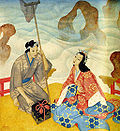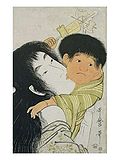- Momotarō
-
 Bisque doll of Momotarō
Bisque doll of Momotarō
Momotarō (桃太郎) is a popular hero from Japanese folklore. His name literally means Peach Tarō; as Tarō is a common Japanese boy's name, it is often translated as Peach Boy. Momotarō is also the title of various books, films, and other works that portray the tale of this hero.
Contents
Story
According to the present form of the tale (dating to the Edo period), Momotarō came to Earth inside a giant peach, which was found floating down a river by an old, childless woman who was washing clothes there. The woman and her husband discovered the child when they tried to open the peach to eat it. The child explained that he had been sent by Heaven to be their son. The couple named him Momotarō, from momo (peach) and tarō (eldest son in the family).[1]
Years later, Momotarō left his parents to fight a band of marauding oni (demons or ogres) on a distant island. En route, Momotarō met and befriended a talking dog, monkey, and pheasant, who agreed to help him in his quest. At the island, Momotarō and his animal friends penetrated the demons' fort and beat the band of demons into surrendering. Momotarō and his new friends returned home with the demons' plundered treasure and the demon chief as a captive. Momotarō and his family lived comfortably from then on.[1]
Momotarō is strongly associated with Okayama, and his tale may have its origins there. The demon island (Onigashima (鬼ヶ島)) of the story is sometimes associated with Megijima Island, an island in the Seto Inland Sea near Takamatsu, due to the vast manmade caves found on that island.[2][3]
Variants
There are a few variants to the story, depending on geographical region. Some say Momotaro floated by in a box, a white peach, or a red peach. Stories from Shikoku and Chugoku region muddy the distinction with characters from another folk story, the Monkey-Crab Battle that Momotaro took with him allies to Oni Island, namely a bee (蜂 hachi), a crab (蟹 kani), a mill stone (臼 usu), a chestnut (栗 kuri), and a cowpie (牛の糞 ushi no hun).[4] In old days, all these animals and objects were believed to possess spirits and could move by their own will. The cowpie was sometimes given the honorific dono (殿). This was to appease the cowpie spirit, so as it won't move to be under you when you stumble or take a step.[citation needed]
Momotaro Festival
Inuyama, Japan holds a festival every years called the Momotaro Festival held at the Momotaro Shrine on May 5 every year.
Momotarō's song
Statue of Momotaro outside of Okayama Train Station
The popular children's song about Momotarō titled Momotarō-san no Uta (Momotarō's Song) was first published in 1911. One version of it is included below with romanization and translation.
« Momotarō-san no uta » 桃太郎さんの歌Momotarō-san, Momotarō-san (Momotarō, Momotarō) 桃太郎さん、桃太郎さん
Okoshi ni tsuketa kibidango (Those millet dumplings on your waist) お腰につけたきびだんご
Hitotsu watashi ni kudasai na? (Won't you give me one?) 一つ私に下さいな!
Agemashō, agemashō (I'll give you one, I'll give you one) あげましょう、あげましょう
Kore kara oni no seibatsu ni (From now, on a quest to conquer the ogres) これから鬼の征伐に
Tsuite kuru nara agemashō (If you come with me, I'll give one to you) ついてくるならあげましょう
World War II
Momotaro was an immensely popular figure during World War II, appearing in many wartime films and cartoons.[5]
References
- ^ a b Ozaki, Yei Theodora (1903). "Momotaro, or the story of the Son of a Peach". The Japanese Fairy Book. Archibald Constable & Co.. http://books.google.com/books?id=V_RyPbadxJgC.
- ^ "Oni-ga-shima(or Megijima)". Archived from the original on 2008-01-10. http://web.archive.org/web/20080110004627/http://www.city.takamatsu.kagawa.jp/english/kankou/B1e.html. Retrieved 2010-09-01.
- ^ "Megi-jima/Ogi-jima". Takamatsu City Web Site. http://www.city.takamatsu.kagawa.jp/english/sightseeing/spot/megi-jimaogi-jima.html. Retrieved 2010-09-01.
- ^ "桃太郎". Archived from the original on 2008-02-08. http://web.archive.org/web/20080208142021/http://www.f49m24.niknak.ne.jp/~kire/sub1-21.htm. Retrieved 2010-09-01. (Japanese)
- ^ John W. Dower, War Without Mercy: Race & Power in the Pacific War p253 ISBN 0-394-50030-X
See also
Japanese folklore 
Folktales Taketori Monogatari · Urashima Tarō · Kintarō · Momotarō · Saru Kani Gassen · Tamamo-no-Mae · Issun-bōshi · Shita-kiri Suzume · Bunbuku Chagama · Yotsuya Kaidan · Hanasaka Jiisan · Kachi-kachi Yama · Tawara Tōda
Text collections Legendary creatures Categories:- Japanese folklore
- Japanese fairy tales
Wikimedia Foundation. 2010.

